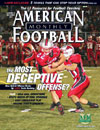AMERICAN FOOTBALL MONTHLY THE #1 RESOURCE FOR FOOTBALL COACHES
Article CategoriesAFM Magazine
|
The Shotgun Zone Fly: Benefits of a Diversified Run Gameby: Michael Parker© More from this issue More and more teams are realizing the benefits of a diverse run game based out of the shotgun. Coach Bryon Hamilton, at Foothill High in Palo Cedro, CA, implemented his own shotgun system several years ago. The system, which he calls the Shotgun Zone Fly Offense, dovetails well with the popular Spread offense. Since developing the SZF, Foothill has become one of the top teams in their classification and is known for one of the most formidable running attacks in northern California. “When I was in the process of developing the offense I was committed to making our blocking schemes easy to understand and easy to execute against the myriad of fronts that we encounter,” says Hamilton. “We use a combination of zone blocks and man blocking schemes so we developed simple rules for both. By having simple rules our linemen can focu....The full article can only be seen by subscribers. Subscribe today!
|
|
|||||||
| HOME |
MAGAZINE |
SUBSCRIBE | ONLINE COLUMNISTS | COACHING VIDEOS |
Copyright 2025, AmericanFootballMonthly.com
All Rights Reserved





